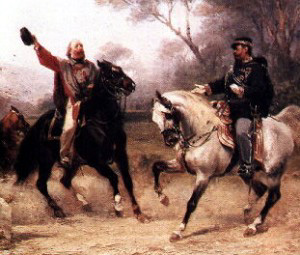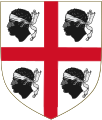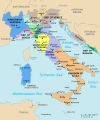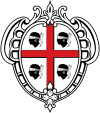مملكة سردينيا
مملكة سردينيا | |
|---|---|
| 1297—1861 | |
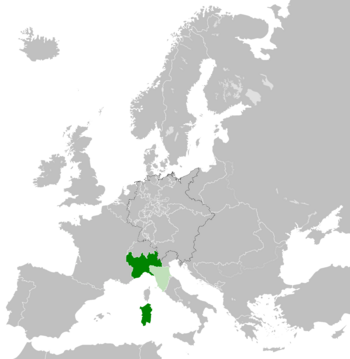 Kingdom of Sardinia-Piedmont in 1859 including conquest of Lombardy; client state in light green | |
| العاصمة | |
| اللغات الشائعة | During the Iberian period in Sardinia: Sardinian, Corsican, Catalan and Spanish;[5] During the Savoyard period as a composite State: Also Italian (already officially used in the mainland since the 16th century via the Rivoli Edict; introduced to Sardinia in 1760[6][7][8][9]), French (officially used in the mainland since the 16th century via the Rivoli Edict), Piedmontese, Ligurian, Occitan and Arpitan |
| الدين | Roman Catholicism (official)[10] |
| صفة المواطن | Sardinian |
| الحكومة |
|
| King | |
• 1324–1327 (first) | James II |
• 1849–1861 (last) | Victor Emmanuel II |
| Prime Minister | |
• 1848 (first) | Cesare Balbo |
• 1860–1861 (last) | Camillo Benso |
| التشريع | Parliament (from 1848) |
| Subalpine Senate (from 1848) | |
| Chamber of Deputies (from 1848) | |
| الحقبة التاريخية | Middle Ages, Early modern, Late modern |
| 1297 | |
| 1324 | |
| 1708 | |
| 1717 | |
| 1720 | |
| 1848 | |
| 1860 | |
| 17 March 1861 | |
| التعداد | |
• 1821 | 3,974,500[11] |
| Currency |
|
| Today part of | |
 |
| تاريخ سردينيا |
مملكة سردينيا كيان سياسي أسسه الأراگون الكاتالان في جزيرة سردينيا في عهد الملك خاومي الثاني سنة 1324 مر بعدة تحولات إلى أن غيـّر اسمه عام 1861 إلى مملكة إيطاليا بإعلان من ملكها الرابعة والعشرين فيكتور عمانويل الثاني ساڤويا.
أنشأ البابا بونيفاسيوس الثامن المملكة على الخريطة في سنة 1297 تحت اسم مملكة سردينيا وكورسيكا لتحل الازمة السياسية والدبلوماسية بين تاج أراغون و دوقية أنجو على صقلية (حرب صلاة الغروب) .
لـُـمس تحقق الفعلي لمملكة سردينيا بالحرب بين الأراغونيين الكاتالان ضد بيزا التحالفة مع مملكة أربوريا القضائية. واجهوا مقاومة طويلة على الجزيرة من نفس مملكة أربوريا ، و لم يتمكنوا من الحاق الهزيمة النهائية بالمملكة القضائية إلا في سنة 1420.
طول مدة التأسيس التاريخي للمملكة ومرورها بمراحل تاريخية مختلفة صنعا جغرافيا تاريخية مشتركة تميزها فترات مختلفة في خدمة الكيان السياسي السائد: فترة أراغونية، وأخرى إسبانية، وأخيرة سافوائية .
The kingdom was a member of the Council of Aragon and initially consisted of the islands of Corsica and Sardinia, sovereignty over both of which was claimed by the papacy, which granted them as a fief, the regnum Sardiniae et Corsicae ("kingdom of Sardinia and Corsica"[12]), to King James II of Aragon in 1297.[13] Beginning in 1324, James and his successors conquered the island of Sardinia and established de facto their de jure authority. In 1420, after the Sardinian–Aragonese war, the last competing claim to the island was bought out. After the union of the crowns of Aragon and Castile, Sardinia became a part of the burgeoning Spanish Empire.
In 1720, the island and its kingdom were ceded by the Habsburg and Bourbon claimants to the Spanish throne to the Duke of Savoy, Victor Amadeus II. The Savoyards united it with their historical possessions on the Italian mainland, and the kingdom came to be progressively identified with the mainland states, which included, besides Savoy and Aosta, dynastic possessions like the Principality of Piedmont and the County of Nice, over both of which the Savoyards had been exercising their control since the 13th century and 1388, respectively. The formal name of this composite state was the "States of His Majesty the King of Sardinia",[14] and it was and is referred to as either Sardinia–Piedmont,[15][16] Piedmont–Sardinia, or erroneously the Kingdom of Piedmont, since the island of Sardinia had always been of secondary importance to the monarchy.[17] Under Savoyard rule, the kingdom's government, ruling class, cultural models and center of population were entirely situated in the mainland.[18] Therefore, while the capital of the island of Sardinia and the seat of its viceroys had always been de jure Cagliari, it was the Piedmontese city of Turin, the capital of Savoy since the mid 16th century, which was the de facto seat of power. This situation would be conferred official status with the Perfect Fusion of 1847, when all the kingdom's governmental institutions would be centralized in Turin.
When the mainland domains of the House of Savoy were occupied and eventually annexed by Napoleonic France, the king of Sardinia temporarily resided on the island for the first time in Sardinia's history under Savoyard rule. The Congress of Vienna (1814–15), which restructured Europe after Napoleon's defeat, returned to Savoy its mainland possessions and augmented them with Liguria, taken from the Republic of Genoa. Following Geneva's accession to Switzerland, the Treaty of Turin (1816) transferred Carouge and adjacent areas to the newly created Swiss Canton of Geneva. In 1847–48, through an act of Union analogous to the one between Great Britain and Ireland, the various Savoyard states were unified under one legal system with their capital in Turin, and granted a constitution, the Statuto Albertino.
By the time of the Crimean War in 1853, the Savoyards had built the kingdom into a strong power. There followed the annexation of Lombardy (1859), the central Italian states and the Two Sicilies (1860), Venetia (1866), and the Papal States (1870). On 17 March 1861, to more accurately reflect its new geographic, cultural and political extent, the Kingdom of Sardinia changed its name to the Kingdom of Italy, and its capital was eventually moved first to Florence and then to Rome. The Savoy-led Kingdom of Piedmont-Sardinia was thus the legal predecessor of the Kingdom of Italy, which in turn is the predecessor of the present-day Italian Republic.[19]
التاريخ المبكر
In 238 BC Sardinia became, along with Corsica, a province of the Roman Empire. The Romans ruled the island until the middle of the 5th century when it was occupied by the Vandals, who had also settled in north Africa. In 534 AD it was reconquered by the Eastern Roman (Byzantine) Empire. It remained a Byzantine province until the Arab conquest of Sicily in the 9th century. After that, communications with Constantinople became very difficult, and powerful families of the island assumed control of the land.
Facing Arab attempts to sack and conquer, while having almost no outside help, Sardinia used the principle of translatio imperii ("transfer of rule") and continued to organize itself along the ancient Roman and Byzantine model. The island was not the personal property of the ruler and of his family, as was then the dominant practice in western Europe, but rather a separate entity and during the Byzantine Empire, a monarchical republic, as it had been since Roman times.
Starting from 705 to 706, Saracens from north Africa (recently conquered by Arab armies) harassed the population of the coastal cities. Information about the Sardinian political situation in the following centuries is scarce. Due to Saracen attacks, in the 9th century Tharros was abandoned in favor of Oristano, after more than 1800 years of occupation; Caralis, Porto Torres and numerous other coastal centres suffered the same fate. There is a record of another massive Saracen sea attack in 1015–16 from the Balearics, commanded by Mujāhid al-ʿĀmirī (Latinized as Museto). The Saracen attempt to invade the island was stopped by the Judicates with the support of the fleets of the maritime republics of Pisa and Genoa. Pope Benedict VIII also requested aid from the two maritime republics in the struggle against the Arabs.[20]
After the Great Schism, Rome made many efforts to restore Latinity to the Sardinian church, politics and society, and to finally reunify the island under one Catholic ruler, as it had been for all of southern Italy, when the Byzantines had been driven away by Catholic Normans. Even the title of "Judge" was a Byzantine reminder of the Greek church and state,[21] in times of harsh relations between eastern and western churches (Massacre of the Latins, 1182, Siege of Constantinople (1204), Recapture of Constantinople, 1261).
Before the Kingdom of Sardinia and Corsica, the Archons (ἄρχοντες) or, in Latin, judices,[22][23] who reigned in the island from the 9th or 10th century until the beginning of the 11th century, can be considered real kings of all Sardinia (Κύριε βοήθε ιοῦ δού λού σου Tουρκοτουρίου ἅρχωντοσ Σαρδινίας καί τής δού ληςσου Γετιτ[24]),[25][26] even though nominal vassals of the Byzantine emperors. Of these sovereigns, only two names are known: Turcoturiu and Salusiu (Tουρκοτουριου βασιλικου προτοσπαθαριου [27] και Σαλουσιου των ευγενεστατων άρχωντων),[28][29] who probably ruled in the 10th century. The Archons still wrote in Greek or Latin, but one of the oldest documents left of the Judicate of Cagliari (the so-called Carta Volgare), issued by Torchitorio I de Lacon-Gunale in 1070, was already written in the Romance Sardinian language, albeit with the Greek alphabet.[30]
The realm was divided into four small kingdoms, the Judicates of Cagliari, Arborea, Gallura and Logudoro, perfectly organized as was the previous realm, but was now under the influence of the papacy, which claimed sovereignty over the entire island, and in particular of the Italian states of Genoa and Pisa, that through alliances with the "judges" (the local rulers), secured their political and economic zones of influence. While Genoa was mostly, but not always, in the north and west regions of Sardinia, that is, in the Judicates of Gallura and Logudoro; Pisa was mostly, but not always, in the south and east, in the Judicates of Cagliari and Arborea.[31][32] That was the cause of conflicts leading to a long war between the Judges, who regarded themselves as kings fighting against rebellious nobles.[33][34]

Later, the title of King of Sardinia was granted by the Emperor of the Holy Roman Empire to Barisone II of Arborea[35] and Enzio of Sardinia. The first could not reunify the island under his rule, despite years of war against the other Sardinian judges, and he finally concluded a peace treaty with them in 1172.[36] The second did not have the opportunity. Invested with the title from his father, Emperor Frederick II in 1239, he was soon recalled by his parent and appointed Imperial Vicar for Italy. He died in 1272 without direct recognized heirs after a detention of 23 years in a prison in Bologna.
The Kingdom of Sardinia and Corsica (later, just the "Kingdom of Sardinia" from 1460[37]) was a state whose king was the King of Aragon, who started to conquer it in 1324, gained full control in 1410, and directly ruled it until 1460. In that year it was incorporated into a sort of confederation of states, each with its own institutions, called the Crown of Aragon, and united only in the person of the king. The Crown of Aragon was made by a council of representatives of the various states and grew in importance for the main purpose of separating the legacy of Ferdinand II of Aragon from that of Isabella I of Castile when they married in 1469.
The idea of the kingdom was created in 1297 by Pope Boniface VIII, as a hypothetical entity created for James II of Aragon under a secret clause in the Treaty of Anagni. This was an inducement to join in the effort to restore Sicily, then under the rule of James's brother Frederick III of Sicily, to the Angevin dynasty over the oppositions of the Sicilians. The two islands proposed for this new kingdom were occupied by other states and fiefs at the time. In Sardinia, three of the four states that had succeeded Byzantine imperial rule in the 9th century had passed through marriage and partition under the direct or indirect control of Pisa and Genoa in the 40 years preceding the Anagni treaty. Genoa had also ruled Corsica since conquering the island nearly two centuries before (c. 1133).
There were other reasons beside this papal decision: it was the final successful result of the long fight against the Ghibelline (pro-imperial) city of Pisa and the Holy Roman Empire itself. Furthermore, Sardinia was then under the control of the very Catholic kings of Aragon, and the last result of rapprochement of the island to Rome. The Sardinian church had never been under the control of the Ecumenical Patriarchate of Constantinople; it was an autonomous province loyal to Rome and belonging to the Latin Church, but during the Byzantine period became influenced by Byzantine liturgy and culture.
Sardinia under Aragonese and Spanish domination

Changeover to the House of Savoy
الحروب الناپليونية ومؤتمر ڤيينا
مملكة سردينيا (1720-1861)
مملكة سردينيا هو الاسم الذي اتخذته دولة ساڤوي في سنة 1720 ، عندما تحصل آل ساڤوا على تاج سردينيا وما تبع ذلك من ضم إلى ممتلكاتهم.
رغم أن مملكة سردينيا السفوية تمثل من الناحية الشكلية استمراراً لمملكة سردينيا القديمة ، إلا أنها في الجوهر لا تزال من دون انقطاع استمراراً لدوقية ساڤويا وهي توسع لها . تـُعرف مملكة سردينيا في هذه المرحلة من تاريخها أيضا باسم مملكة پييمونتي - سردينيا و كثيرا ما تذكر في كتب التاريخ باسم "مملكة السفوية" أو بأكثر بساطة "بييمونتي".
تشكلت المملكة الجديدة باتحاد العديد من الممتلكات تحت نفس الاسم و تحت مـُـلك واحد ، كان من أهمها إمارة بييمونتي و دوقية سافويا و كونتية نيس بالإضافة إلى مملكة سردينيا نفسها التي ألحقت بها دوقية جنوا ، بعد ضم جمهورية جنوا الذي قرره مؤتمر فيينا.
بالانتقال حتى الرسمي لمؤسسات الدولة (بعد الاتحاد الكامل مع دول البر الرئيسى سنة 1847) أصبحت الجزيرة إقليماً في دولة أكبر ستحتفظ باسم مملكة سردينيا لبضع سنوات أخرى، حتى تحقق هدف ضم الدول والأراضي الأخرى في شبه الجزيرة الإيطالية ، وستتغير التسمية إلى مملكة إيطاليا .
فترة ساڤوا
تبادل سردينيا مقابل صقلية
The Spanish domination of Sardinia ended at the beginning of the 18th century, as a result of the War of the Spanish Succession. By the Treaty of Utrecht of 1713, Spain's European empire was divided: Savoy received Sicily and parts of the Duchy of Milan, while Charles VI (the Holy Roman Emperor and Archduke of Austria), received the Spanish Netherlands, the Kingdom of Naples, Sardinia, and the bulk of the Duchy of Milan.
During the War of the Quadruple Alliance, Victor Amadeus II, Duke of Savoy and King of Sicily, had to agree to yield Sicily to the Austrian Habsburgs and receive Sardinia in exchange. The exchange was formally ratified in the Treaty of The Hague of 17 February 1720. Because the Kingdom of Sardinia had existed since the 14th century, the exchange allowed Victor Amadeus to retain the title of king in spite of the loss of Sicily.
Victor Amadeus initially resisted the exchange, and until 1723 continued to style himself King of Sicily rather than King of Sardinia. The state took the official title of Kingdom of Sardinia, Cyprus and Jerusalem, as the House of Savoy still claimed the thrones of Cyprus and Jerusalem, although both had long been under Ottoman rule.
In 1767–1769, Charles Emmanuel III annexed the Maddalena archipelago in the Strait of Bonifacio from the Republic of Genoa and claimed it as part of Sardinia. Since then the archipelago has been a part of the Sardinian region.
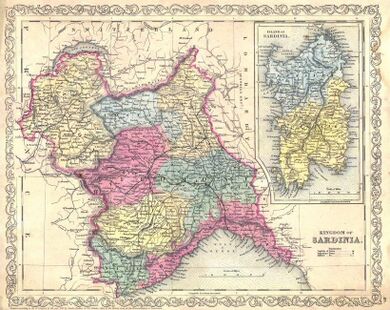
الحروب النابليونية ومؤتمر فيينا
In 1792, the Kingdom of Sardinia and the other states of the Savoy Crown joined the First Coalition against the French First Republic, but was beaten in 1796 by Napoleon and forced to conclude the disadvantageous Treaty of Paris (1796), giving the French army free passage through Piedmont. On 6 December 1798 Joubert occupied Turin and forced Charles Emmanuel IV to abdicate and leave for the island of Sardinia. The provisionary government voted to unite Piedmont with France. In 1799 the Austro-Russians briefly occupied the city, but with the Battle of Marengo (1800), the French regained control. The island of Sardinia stayed out of the reach of the French for the rest of the war and was, for the first time in centuries governed directly by its king instead of a viceroy.
In 1814, the Crown of Savoy enlarged its territories with the addition of the former Republic of Genoa, now a duchy, and it served as a buffer state against France. This was confirmed by the Congress of Vienna, which returned the region of Savoy to its borders after it had been annexed by France in 1792.[38] By the Treaty of Stupinigi, the Kingdom of Sardinia extended its protectorate over the Principality of Monaco.
In the reaction after Napoleon, the country was ruled by conservative monarchs: Victor Emmanuel I (1802–21), Charles Felix (1821–31) and Charles Albert (1831–49), who fought at the head of a contingent of his own troops at the Battle of Trocadero, which set the reactionary Ferdinand VII on the Spanish throne. Victor Emmanuel I disbanded the entire Code Napoléon and returned the lands and power to the nobility and the Church. This reactionary policy went as far as discouraging the use of roads built by the French. These changes typified Sardinia.
The Kingdom of Sardinia industrialized from 1830 onward. A constitution, the Statuto Albertino, was enacted in the year of revolutions, 1848 under liberal pressure. In the same year the island of Sardinia, a Piedmontese dependency for more than a century, lost its own residual autonomy to the mainland through the so-called Perfect fusion issued by Charles Albert; as a result, the kingdom's fundamental institutions were deeply transformed, assuming the shape of a constitutional and centralized monarchy on the French model; under the same pressure, Charles Albert declared war on Austria. After initial success, the war took a turn for the worse and Charles Albert was defeated by Marshal Radetzky at the Battle of Custozza (1848).
نضال ساڤوا بتوحيد إيطاليا
Like all the various duchies and city-states on the Apennine peninsula and associated islands, the Kingdom of Sardinia was troubled with political instability under alternating governments. After a short and disastrous renewal of the war with Austria in 1849, Charles Albert abdicated on 23 March 1849 in favour of his son Victor Emmanuel II.
In 1852, a liberal ministry under Count Camillo Benso di Cavour was installed and the Kingdom of Sardinia became the engine driving Italian unification. The Kingdom of Sardinia took part in the Crimean War, allied with the Ottoman Empire, Britain, and France, and fighting against Russia.
In 1859, France sided with the Kingdom of Sardinia in a war against Austria, the Austro-Sardinian War. Napoleon III did not keep his promises to Cavour to fight until all of the Kingdom of Lombardy–Venetia had been conquered. Following the bloody battles of Magenta and Solferino, both French victories, Napoleon thought the war too costly to continue and made a separate peace behind Cavour's back in which only Lombardy would be ceded.
Due to the Austrian government's refusal to cede any lands to the Kingdom of Sardinia, they agreed to cede Lombardy to Napoleon, who in turn then ceded the territory to the Kingdom of Sardinia to avoid "embarrassing" the defeated Austrians. Cavour angrily resigned from office when it became clear that Victor Emmanuel would accept this arrangement.
گاريبالدي والألف
On 5 March 1860, Piacenza, Parma, Tuscany, Modena, and Romagna voted in referendums to join the Kingdom of Sardinia. This alarmed Napoleon III, who feared a strong Savoyard state on his south-eastern border and he insisted that if the Kingdom of Sardinia were to keep the new acquisitions they would have to cede Savoy and Nice to France. This was done through the Treaty of Turin, which also called for referendums to confirm the annexation. Subsequently, somewhat controversial referendums showed over 99.5% majorities in both areas in favour of joining France.[39]
In 1860, Giuseppe Garibaldi started his campaign to conquer the southern Apennines in the name of the Kingdom of Sardinia. He quickly toppled the Kingdom of the Two Sicilies, which was the largest of the states in the region, stretching from Abruzzo and Naples on the mainland to Messina and Palermo on Sicily. He then marched to Gaeta in the central peninsula. Cavour was satisfied with the unification, while Garibaldi, who was too revolutionary for the king and his prime minister, wanted to conquer Rome as well.
Garibaldi was disappointed in this development, as well as in the loss of his home province, Nice, to France. He also failed to fulfill the promises that had gained him popular and military support by the Sicilians: that the new nation would be a republic, not a kingdom, and that the Sicilians would see great economic gains after unification. The former did not come to pass until 1946.
صوب مملكة إيطاليا
On 17 March 1861, law no. 4671 of the Sardinian Parliament proclaimed the Kingdom of Italy, so ratifying the annexations of all other Apennine states, plus Sicily, to the Kingdom of Sardinia.[40] The institutions and laws of the kingdom were quickly extended to all of Italy, abolishing the administrations of the other regions. Piedmont became the most dominant and wealthiest region in Italy and the capital of Piedmont, Turin, remained the Italian capital until 1865, when the capital was moved to Florence. But many revolts exploded throughout the peninsula, especially in southern Italy, and on the island of Sicily, because of the perceived unfair treatment of the south by the Piedmontese ruling class. The House of Savoy ruled Italy until 1946, when Italy was declared a republic by referendum. The result was 54.3% in favor of the Republic.
Flags, royal standards and coats of arms
When the Duchy of Savoy acquired the Kingdom of Sicily in 1713 and the Kingdom of Sardinia in 1723, the flag of Savoy became the flag of a naval power. This posed the problem that the same flag was already in use by the Knights of Malta. Because of this, the Savoyards modified their flag for use as a naval ensign in various ways, adding the letters FERT in the four cantons, or adding a blue border, or using a blue flag with the Savoy cross in one canton.
Eventually, King Charles Albert of Savoy adopted the "revolutionary" Italian tricolor, surmounted by the Savoyard shield, as his flag. This flag would later become the flag of the Kingdom of Italy, and the tricolor without the Savoyard escutcheon remains the flag of Italy.
- Coats of arms
Middle Ages
(union with Aragon)
- State Flags
- Other Flags
Merchant Flag
(ح. 1799–1802)War Ensign of the Royal Sardinian Navy (1785–1802)
Civil and merchant flag (1851–1861), the Italian tricolore with the coat of arms of Savoy as an inescutcheon
- Royal Standards
Maps
Territorial evolution of Sardinia from 1324 to 1720
The Kingdom of Sardinia from 1410 to 1420, after the defeat of the Arborean Judicate in the Battle of Sanluri (1409).
The Kingdom of Sardinia from 1448 to 1720; the Maddalena archipelago was conquered in 1767–69.
Territorial evolution of Italy from 1796 to 1860
- 1859:Kingdom of Sardinia
- 1860:Kingdom of Sardinia
After the annexation of Lombardy, the Grand Duchy of Tuscany, the Emilian Duchies and Pope's Romagna.
انظر أيضاً
- قائمة ملوك سردينيا
- List of viceroys of Sardinia
- الإمبراطورية الإسپانية
- S'hymnu sardu nationale
- مملكة سردينيا (1700–1720)
Notes and references
الهامش
Notes
- ^ The Kingdom was initially called Regnum Sardiniae et Corsicae, in that it was originally meant to also include the neighbouring island of Corsica, until its status as a Genoese land was eventually acknowledged by Ferdinand II of Aragon, who dropped the last original bit mentioning Corsica in 1479 (Francesco Cesare, Casula. Italia, il grande inganno 1861–2011. Carlodelfino Editore. pp. 32, 49). However, every king of Sardinia continued to retain the nominal title of Rex Corsicae ("King of Corsica").
- ^ "Storia dello stemma." (in الإيطالية). Retrieved 31 Jan 2023.
- ^ أ ب "Bandiere degli Stati preunitari italiani: Sardegna.". Archived from the original on 31 May 2019. Retrieved 31 May 2019.
- ^ أ ب "Flags of the World: Kingdom of Sardinia – Part 2 (Italy).". Archived from the original on 25 February 2017. Retrieved 31 May 2019.
- ^ Storia della lingua sarda, vol. 3, a cura di Giorgia Ingrassia e Eduardo Blasco Ferrer
- ^ The phonology of Campidanian Sardinian : a unitary account of a self-organizing structure, Roberto Bolognesi, The Hague : Holland Academic Graphics
- ^ S'italianu in Sardìnnia, Amos Cardia, Iskra
- ^ Settecento sardo e cultura europea: Lumi, società, istituzioni nella crisi dell'Antico Regime; Antonello Mattone, Piero Sanna; FrancoAngeli Storia; p. 18
- ^ "Limba Sarda 2.0S'italianu in Sardigna? Impostu a òbligu de lege cun Boginu – Limba Sarda 2.0". Limba Sarda 2.0. Retrieved 28 November 2015.
- ^ Seiwert, Hubert (2011). Religious intolerance and discrimination in selected European countries. LIT Verlag Münster. p. 166. ISBN 978-3-643-99894-1.
In 1848, the Statute or constitution issued by King Carlo Alberto for the kingdom of Sardinia (better known as Piedmont, from its capital in Turin) proclaimed "the only State religion" the Roman Catholic one.
- ^ Cummings, Jacob (1821). An Introduction to Ancient and Modern Geography. Cummings and Hilliard. p. 98. ISBN 978-1-341-37795-2. Retrieved 11 May 2022.
- ^ Schena, Olivetta (2012), Gamberini, Andrea; Lazzarini, Isabella, eds., The kingdom of Sardinia and Corsica, Cambridge: Cambridge University Press, pp. 50–68, ISBN 978-0-511-84569-7, https://www.cambridge.org/core/books/italian-renaissance-state/kingdom-of-sardinia-and-corsica/4CD0B779F367012B7AFE6D28BBB6423B, retrieved on 2023-01-19
- ^ Cioppi, Alessandra (2021), Sabaté, Flocel, ed., The Crown of Aragon and the Regnum Sardiniae et Corsicae in the Fourteenth Century: Comparing Institutional Identities, CARMEN Monographs and Studies, Amsterdam University Press, pp. 329–346, ISBN 978-1-64189-259-9, https://www.cambridge.org/core/books/abs/identity-in-the-middle-ages/crown-of-aragon-and-the-regnum-sardiniae-et-corsicae-in-the-fourteenth-century-comparing-institutional-identities/70248955CCC63437EBDC7B70EBD31A1B, retrieved on 2024-08-29
- ^ Christopher Storrs, "Savoyard Diplomacy in the Eighteenth Century (1684–1798)", in Daniela Frigo (ed.), Politics and Diplomacy in Early Modern Italy: The Structure of Diplomatic Practice, 1450–1800 (Cambridge University Press, 2000), p. 210.
- ^ "Sardinia-Piedmont, Kingdom of, 1848-1849". www.ohio.edu. Retrieved 2023-01-19.
- ^ خطأ استشهاد: وسم
<ref>غير صحيح؛ لا نص تم توفيره للمراجع المسماة:12 - ^ Carlos Ramirez-Faria (2007). Concise Encyclopeida Of World History. Atlantic Publishers & Dist. p. 644. ISBN 978-81-269-0775-5.
- ^ "Sardinia, Historical Kingdom". 20 December 2023., Encyclopædia Britannica
- ^ Aldo Sandulli; Giulio Vesperini (2011). "L'organizzazione dello Stato unitario" (PDF). Rivista trimestrale di diritto pubblico (in الإيطالية): 47–49. Archived from the original (PDF) on 2 November 2018. Retrieved 19 March 2013.
- ^ B. Maragonis, Annales pisani a. 1004–1175, ed. K. Pertz, in MGH, Scriptores, 19, Hannoverae, 1861/1963, pp. 236–2 and Gli Annales Pisani di Bernardo Maragone, a cura di M. L. Gentile, in Rerum Italicarum Scriptores, n.e., VI/2, Bologna 1930, pp. 4–7. "1017. Fuit Mugietus reversus in Sardineam, et cepit civitatem edificare ibi atque homines Sardos vivos in cruce murare. Et tunc Pisani et Ianuenses illuc venere, et ille propter pavorem eorum fugit in Africam. Pisani vero et Ianuenses reversi sunt Turrim, in quo insurrexerunt Ianuenses in Pisanos, et Pisani vicerunt illos et eiecerunt eos de Sardinea."
- ^ "Sardegna Cultura – Periodi storici – Giudicale". www.sardegnacultura.it. Retrieved 2021-08-02.
- ^ C. Zedda-R. Pinna, La nascita dei giudicati, proposta per lo scioglimento di un enigma storiografico, su Archivio Storico Giuridico Sardo di Sassari, vol. n°12, 2007, Dipartimento di Scienze Giuridiche dell'Università di Sassari
- ^ F. Pinna, Le testimonianze archeologiche relative ai rapporti tra gli Arabi e la Sardegna nel medioevo, in Rivista dell'Istituto di storia dell'Europa mediterranea, Consiglio Nazionale delle Ricerche, n°4, 2010
- ^ Archeological museum of Cagliari, from Santa Sofia church in Villasor
- ^ "Antiquitas nostra primum Calarense iudicatum, quod tunc erat caput tocius Sardinie, armis subiugavit, et regem Sardinie Musaitum nomine civitati Ianue captum adduxerunt, quem per episcopum qui tunc Ianue erat, aule sacri palatii in Alamanniam mandaverunt, intimantes regnum illius nuper esse additum ditioni Romani imperii." – Oberti Cancellarii, Annales p 71, Georg Heinrich (a cura di) MGH, Scriptores, Hannoverae, 1863, XVIII, pp. 56–96
- ^ Crónica del califa 'Abd ar-Rahmân III an-Nâsir entre los años 912–942,(al-Muqtabis V), édicion. a cura de P. CHALMETA – F. CORRIENTE, Madrid, 1979, p. 365 "Tuesday, August 24th 942 (A.D.), a messenger of the Lord of the island of Sardinia appeared at the gate of al-Nasir ... asking for a treaty of peace and friendship. With him were the merchants, people Malfat, known in al-Andalus as from Amalfi, with the whole range of their precious goods, ingots of pure silver, brocades etc. ... transactions which drew gain and great benefits"
- ^ Constantini Porphyrogeneti De caerimoniis aulae Byzantinae, in Patrologia cursus completus. Series Graeca CXII, Paris 1857
- ^ R. Coroneo, Scultura mediobizantina in Sardegna, Nuoro, Poliedro, 2000
- ^ Roberto Coroneo, Arte in Sardegna dal IV alla metà dell'XI secolo, edizioni AV, Cagliari 2011
- ^ Ferrer, Eduardo Blasco (1984). Storia Linguistica Della Sardegna, p. 65, De Gruyter
- ^ "Sardinia - Vandal and Byzantine rule". Encyclopedia Britannica (in الإنجليزية). Retrieved 2021-08-02.
- ^ "GIUDICATI in "Enciclopedia Italiana"". www.treccani.it (in الإيطالية). Retrieved 2021-08-02.
- ^ Barisone Doria: "La senyoria no la tenim ne havem haùda ne del rey ne da regina, e no som tenguts a rey ne a regina axi com eren los dits harons de Sicilia, abans de la dita senyoria e domini obtenim per Madonna Elionor, nostra muller, che és jutgessa d'Arborea e filla e succehidora per son pare per lo jutgat d'Arborea, la qual Casa d'Arborea ha D anys que ha hauda senyioria en la present illa" "We had our lordship not from any king or queen and have not to be loyal to any king or queen as sicilian Barons, because we had our lordship from Madonna Elionor, our wife, who is Lady Judge (Juighissa in Sardinian) of Arborea, daughter and successor of her father of the Judicate of Arborea, and this House of Arborea has reigned for five hundreds years in this island." – Archivo de la Corona d'Aragon. Colleccion de documentos inéditos. XLVIII
- ^ "Storia di Sardegna, Pisa e Genova in guerra per il dominio". La Nuova Sardegna (in الإيطالية). 2017-11-10. Retrieved 2021-08-02.
- ^ G. Seche, L'incoronazione di Barisone "Re di Sardegna" in due fonti contemporanee: gli Annales genovesi e gli Annales pisani, in Rivista dell'Istituto di storia dell'Europa mediterranea, Consiglio Nazionale delle Ricerche, n°4, 2010
- ^ Dino Punchu (a cura di), I Libri Iurium della Repubblica de Genova, Ministero per i Beni Culturali e Ambientali, Roma, 1996, n°390, p. 334
- ^ Geronimo Zurita, Los cinco libros postreros de la segunda parte de los Anales de la Corona d'Aragon, Oficino de Domingo de Portonaris y Ursono, Zaragoza, 1629, libro XVII, pp. 75–76
- ^ Wells, H.G., Raymond Postgate, and G.P. Wells. The Outline of History, Being a Plain History of Life and Mankind. Garden City, NY: Doubleday, 1956. p. 753 قالب:ISBN?
- ^ Wambaugh, Sarah & Scott, James Brown (1920), A Monograph on Plebiscites, with a Collection of Official Documents, New York: Oxford University Press, p. 599
- ^ Ortino, Sergio; Zagar, Mitja; Mastny, Vojtech (2005). The Changing Faces of Federalism: Institutional Reconfiguration in Europe From East to West. Manchester University Press. p. 183. ISBN 978-0-7190-6996-3. Retrieved 3 March 2014.
- ^ "Flags of the World: Kingdom of Sardinia – Part 1 (Italy).". Archived from the original on 23 December 2017. Retrieved 31 May 2019.
Bibliography
- Antonicelli, Aldo. "From Galleys to Square Riggers: The modernization of the navy of the Kingdom of Sardinia." The Mariner's Mirror 102.2 (2016): 153–173 online[dead link]
- Hearder, Harry (1986). Italy in the Age of the Risorgimento, 1790–1870. London: Longman. ISBN 0-582-49146-0.
- Luttwak Edward, The Grand Strategy of the Byzantine Empire, The Belknap Press, 2009, ISBN 9780674035195
- Mack Smith, Denis. Victor Emanuel, Cavour and the Risorgimento (Oxford UP, 1971) online.
- Martin, George Whitney (1969). The Red Shirt and the Cross of Savoy. New York: Dodd, Mead and Co. ISBN 0-396-05908-2.
- Murtaugh, Frank M. (1991). Cavour and the Economic Modernization of the Kingdom of Sardinia. New York: Garland Publishing Inc. ISBN 978-0-8153-0671-9.
- Romani, Roberto. "The Reason of the Elites: Constitutional Moderatism in the Kingdom of Sardinia, 1849–1861." in Sensibilities of the Risorgimento (Brill, 2018) pp. 192–244.
- Romani, Roberto. "Reluctant Revolutionaries: Moderate Liberalism in the Kingdom of Sardinia, 1849–1859." Historical Journal (2012): 45–73. online
- Schena, Olivetta. "The role played by towns in parliamentary commissions in the kingdom of Sardinia in the fifteenth and sixteenth centuries." Parliaments, Estates and Representation 39.3 (2019): 304–315.
- Storrs, Christopher (1999). War, Diplomacy and the Rise of Savoy, 1690–1720. Cambridge University Press. ISBN 0-521-55146-3.
- Thayer, William Roscoe (1911). The Life and Times of Cavour vol 1. old interpretations but useful on details; vol 1 goes to 1859]; volume 2 online covers 1859–62
In Italian
- AAVV. (a cura di F. Manconi), La società sarda in età spagnola, Cagliari, Consiglio Regionale della Sardegna, 2 voll., 1992-3
- Blasco Ferrer Eduardo, Crestomazia Sarda dei primi secoli, collana Officina Linguistica, Ilisso, Nuoro, 2003, ISBN 9788887825657
- Boscolo Alberto, La Sardegna bizantina e alto giudicale, Edizioni Della TorreCagliari 1978
- Casula Francesco Cesare, La storia di Sardegna, Carlo Delfino Editore, Sassari, 1994, ISBN 8871380843
- Coroneo Roberto, Arte in Sardegna dal IV alla metà dell'XI secolo, edizioni AV, Cagliari, 2011
- Coroneo Roberto, Scultura mediobizantina in Sardegna, Nuoro, Poliedro, 2000,
- Gallinari Luciano, Il Giudicato di Cagliari tra XI e XIII secolo. Proposte di interpretazioni istituzionali, in Rivista dell'Istituto di Storia dell'Europa Mediterranea, n°5, 2010
- Manconi Francesco, La Sardegna al tempo degli Asburgo, Il Maestrale, Nuoro, 2010, ISBN 9788864290102
- Manconi Francesco, Una piccola provincia di un grande impero, CUEC, Cagliari, 2012, ISBN 8884677882
- Mastino Attilio, Storia della Sardegna Antica, Il Maestrale, Nuoro, 2005, ISBN 9788889801635
- Meloni Piero, La Sardegna Romana, Chiarella, Sassari, 1980
- Motzo Bachisio Raimondo, Studi sui bizantini in Sardegna e sull'agiografia sarda, Deputazione di Storia Patria della Sardegna, Cagliari, 1987
- Ortu Gian Giacomo, La Sardegna dei Giudici, Il Maestrale, Nuoro, 2005, ISBN 9788889801024
- Paulis Giulio, Lingua e cultura nella Sardegna bizantina: testimonianze linguistiche dell'influsso greco, Sassari, L'Asfodelo, 1983
- Spanu Luigi, Cagliari nel seicento, Edizioni Castello, Cagliari, 1999
- Zedda Corrado – Pinna Raimondo, La nascita dei Giudicati. Proposta per lo scioglimento di un enigma storiografico, in Archivio Storico Giuridico di Sassari, seconda serie, n° 12, 2007
- Articles containing لاتينية-language text
- CS1 الإيطالية-language sources (it)
- Short description matches Wikidata
- Articles with hatnote templates targeting a nonexistent page
- Articles containing قطلان-language text
- Articles containing إسپانية-language text
- Articles containing سردينية-language text
- Articles containing إيطالية-language text
- Pages using center with no arguments
- Pages using infobox country or infobox former country with the flag caption or type parameters
- Pages using infobox country or infobox former country with the symbol caption or type parameters
- Articles with dead external links from July 2022
- Kingdom of Sardinia
- Former countries in Europe
- Viceroyalties of the Spanish Empire
- 1324 establishments in Europe
- 1861 disestablishments in Italy
- States and territories established in 1324
- States and territories disestablished in 1861
- History of Sardinia
- Former countries
- ملكيات سابقة في أوروپا
- Island countries
- Christian states
- Spanish Empire in Europe
- دول وأراضي تأسست في 1720
- دول إيطالية قديمة







